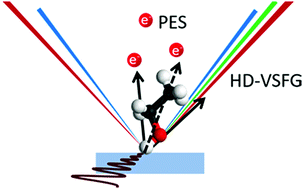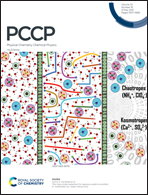The molecular structure of the surface of water–ethanol mixtures†
Abstract
Mixtures of water and alcohol exhibit an excess surface concentration of alcohol as a result of the amphiphilic nature of the alcohol molecule, which has important consequences for the physico-chemical properties of water–alcohol mixtures. Here we use a combination of intensity vibrational sum-frequency generation (VSFG) spectroscopy, heterodyne-detected VSFG (HD-VSFG), and core-level photoelectron spectroscopy (PES) to investigate the molecular properties of water–ethanol mixtures at the air–liquid interface. We find that increasing the ethanol concentration up to a molar fraction (MF) of 0.1 leads to a steep increase of the surface density of the ethanol molecules, and an increased ordering of the ethanol molecules at the surface. When the ethanol concentration is further increased, the surface density of ethanol remains more or less constant, while the orientation of the ethanol molecules becomes increasingly disordered. The used techniques of PES and VSFG provide complementary information on the density and orientation of ethanol molecules at the surface of water, thus providing new information on the molecular-scale properties of the surface of water–alcohol mixtures over a wide range of compositions. This information is invaluable in understanding the chemical and physical properties of water–alcohol mixtures.



 Please wait while we load your content...
Please wait while we load your content...